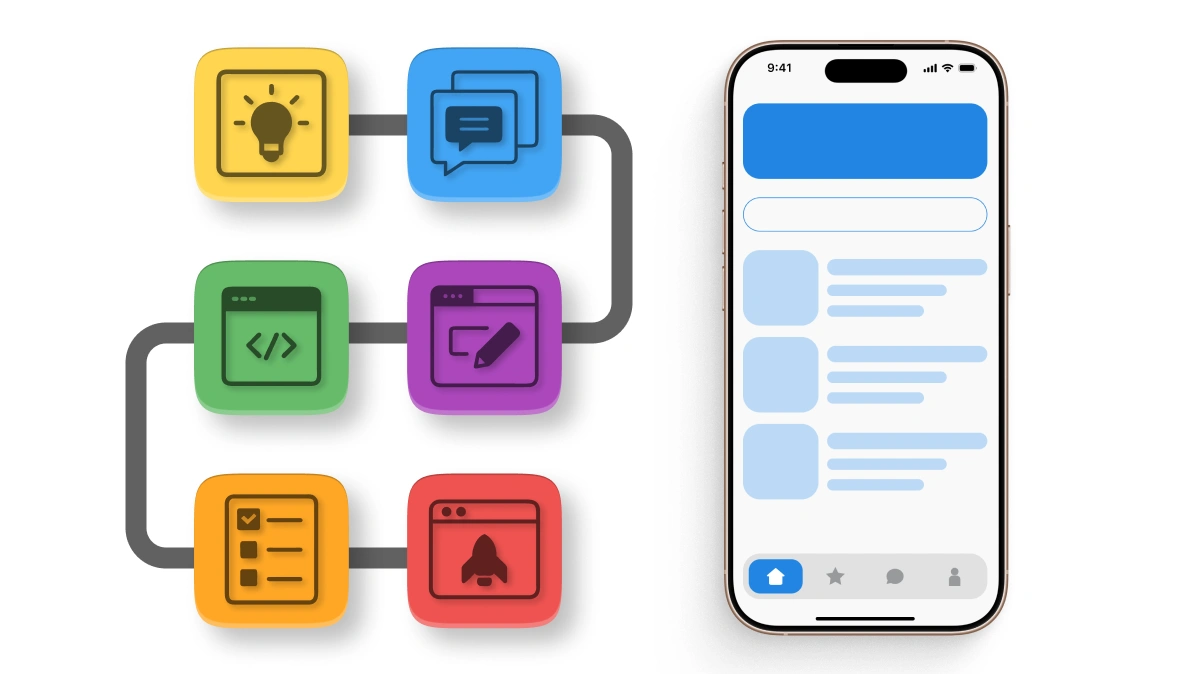
In 2025, accessibility in mobile apps has become a cornerstone of strategies for companies aiming to reach all users, including those with disabilities, and boost engagement. The growing demand for inclusive design and compliance with standards like WCAG makes accessible mobile apps essential for restaurants, stores, services, and small businesses. This article explores why inclusive design is critical, how it reduces user churn, enhances brand reputation, and attracts audiences, and how to optimize apps for organic traffic.
Why Accessibility Matters for Mobile Apps
Accessibility in mobile apps ensures that everyone, regardless of physical or cognitive limitations, can use the product. According to WHO, over 1.5 billion people have disabilities in 2025, making inclusive design both an ethical and commercial necessity. Accessible mobile apps offer:
- Broader audience: Reaching users with visual, auditory, or motor impairments.
- Improved UX: Inclusive design enhances usability for all.
- Legal compliance: Adhering to WCAG avoids penalties.
- Brand reputation: Showcases social responsibility.
SEO Tip: Use keywords like "accessible mobile app", "inclusive design", or "WCAG" in App Store and Google Play descriptions to drive organic traffic.
1. What Is Inclusive Design?
Inclusive design is an approach to creating mobile apps that considers the needs of all users, including those with visual, auditory, motor, or cognitive impairments. It is grounded in universal design principles and WCAG standards.
Core Principles
- Flexibility: Apps adapt to diverse user needs.
- Simplicity: Intuitive navigation for all groups.
- Perceptibility: Content accessible via sight, sound, or touch.
- Error tolerance: Minimizing the impact of mistakes.
How to Implement?
- Follow WCAG 2.1 or WCAG 2.2 standards.
- Use tools like Accessibility Scanner for testing.
- Integrate voice interfaces for ease of use.
2. Accessibility for Visually Impaired Users
Visually impaired users require specific features to interact comfortably with mobile apps.
Benefits
- Screen readers: Compatibility with VoiceOver or TalkBack.
- High contrast: Clear text and element visibility.
- Scalability: Option to enlarge fonts.
How to Implement?
- Add support for VoiceOver and TalkBack in code.
- Ensure contrast ratios meet WCAG 4.5:1 standards.
- Test with WebAIM Contrast Checker.
3. Accessibility for Hearing-Impaired Users
Inclusive design addresses the needs of hearing-impaired users by providing alternative ways to perceive information.
Benefits
- Captions: Text descriptions for audio and video.
- Visual cues: Notifications via vibration or flashes.
- Clear text: Instructions independent of sound.
How to Implement?
- Add captions to all app videos.
- Integrate vibration alerts via Firebase.
- Test with Deque axe for compliance.
4. Accessibility for Users with Motor Impairments
Users with motor impairments need simplified interaction methods for mobile apps.
Benefits
- Large buttons: Easier to tap.
- Voice control: Interaction without physical gestures.
- Adaptive navigation: Compatibility with external devices.
How to Implement?
- Increase button sizes to 48x48 pixels.
- Integrate voice commands via Siri or Google Assistant.
- Test with Switch Access for Android.
5. SEO Optimization for Accessible Apps
SEO optimization enhances the visibility of accessible mobile apps, driving organic traffic and expanding reach.
Benefits
- App store SEO: Higher rankings in App Store and Google Play.
- Content marketing: Blogs on inclusive design attract audiences.
- Social media: Sharing on Instagram or TikTok.
How to Implement?
- Use Google Keyword Planner to select keywords.
- Create SEO-optimized descriptions with phrases like "accessible app".
- Integrate Google My Business for local search.
Inclusive Design Trends in 2025
- Artificial intelligence: AI for adaptive accessibility.
- Voice interfaces: 40% of users prefer voice commands.
- AR for accessibility: Interactive experiences for visually impaired users.
- Biometric security: Protecting user data.
Tips for Creating Accessible Apps
- Identify audience needs: Consider visual, auditory, or motor limitations.
- Follow standards: Use WCAG for design.
- Test accessibility: Use Accessibility Scanner.
- App store SEO: Optimize with keywords.
- Use cross-platform tools: Flutter or React Native.
Inclusive design in mobile apps in 2025 is essential for reaching a broad audience, boosting engagement, and fostering loyalty. Through accessibility, WCAG compliance, and SEO optimization, your business can stand out and succeed in the digital world.

In 2025, UX optimization for mobile apps has become a critical factor in reducing user churn, enhancing engagement, and retaining customers. Rising competition in the digital space and high user expectations for convenience make user experience (UX) pivotal for the success of restaurants, stores, fitness centers, and small businesses. This article explores how UX optimization in mobile apps helps reduce user churn, boost customer loyalty, and increase sales, while optimizing for maximum organic traffic.
Why Is UX Optimization Crucial in 2025?
User experience (UX) determines whether users stay with your mobile app. Analysts report that in 2025, average user churn rates are 20–30% within the first 90 days, but optimized UX can reduce this by 40%. Mobile apps with superior UX offer:
- Intuitiveness: A clear and simple interface lowers user barriers.
- Speed: Optimized performance reduces wait times.
- Personalization: AI tailors content to user preferences.
- Loyalty: Convenient UX encourages regular use.
SEO Tip: Use keywords like "UX optimization", "mobile app", or "reduce churn" in App Store and Google Play descriptions to attract organic traffic.
1. What Is UX and Why Does It Impact Churn?
UX (User Experience) encompasses all aspects of a user’s interaction with a mobile app, from design to functionality. Poor UX, such as complex navigation or slow loading, leads to user churn. Optimized UX ensures ease and satisfaction in app usage.
Benefits of UX Optimization
- Simplicity: Intuitive navigation reduces frustration.
- Speed: Performance optimization cuts load times.
- Personalization: AI delivers relevant content.
- Accessibility: Adaptation for all devices and audiences.
How to Implement?
- Simplify navigation with clear menus and buttons.
- Test speed using tools like Google PageSpeed Insights.
- Integrate AI for personalized recommendations.
2. Reducing Churn Through Intuitive Design
An intuitive UX design reduces user churn by making mobile apps easy and enjoyable to use.
Benefits
- Ease of use: Users quickly find needed features.
- Minimalist design: Fewer elements reduce confusion.
- Consistency: Unified style builds trust.
How to Implement?
- Use Figma or Sketch to create UI/UX prototypes.
- Follow Material Design or Human Interface Guidelines.
- Conduct usability testing with real users.
3. Personalization to Retain Users
Personalization via AI and data analytics significantly reduces user churn by creating a tailored user experience.
Benefits
- Relevant content: Offers tailored to preferences.
- Push notifications: Reminders for promotions or abandoned carts.
- Emotional engagement: Personalized bonuses boost loyalty.
How to Implement?
- Integrate CRM systems like HubSpot for data collection.
- Use Firebase for personalized push notifications.
- Add recommendation systems powered by AI.
4. Optimizing App Performance
A fast and stable mobile app reduces user churn by ensuring a seamless UX.
Benefits
- Fast loading: Users stay engaged without delays.
- Stability: Fewer crashes build trust.
- Energy efficiency: Optimization reduces battery drain.
How to Implement?
- Optimize code with Flutter or React Native.
- Use CDN for faster content delivery.
- Test performance with Lighthouse or TestFlight.
5. SEO Optimization for Mobile Apps
SEO optimization boosts the visibility of mobile apps, attracting organic traffic and reducing user churn.
Benefits
- App store SEO: Higher rankings in App Store and Google Play.
- Content marketing: Blogs about UX attract audiences.
- Social media: Sharing on Instagram or TikTok increases popularity.
How to Implement?
- Use Google Keyword Planner to select keywords.
- Create SEO-optimized descriptions with phrases like "user-friendly app".
- Add Google My Business for local search, e.g., "fitness app".
UX Trends in 2025
- Artificial intelligence: AI for adaptive UX and recommendations.
- Augmented reality: AR for interactive experiences, like menu previews.
- Voice interfaces: 38% of users use voice commands.
- Security: Biometric authentication for data protection.
Tips for UX Optimization
- Define goals: Understand how UX reduces churn for your restaurant or store.
- Create simple designs: Use intuitive navigation.
- Use cross-platform tools: Flutter or React Native.
- Test UX: Conduct usability testing across devices.
- App store SEO: Use keywords like "optimized UX".
UX optimization in mobile apps in 2025 is critical for reducing user churn, enhancing engagement, and building loyalty. Through intuitive design, personalization, fast performance, and SEO optimization, your business can retain users and boost rankings in App Store and Google Play. Invest in UX to ensure your mobile app thrives in the digital world.

In 2025, gamification has become a pivotal tool for mobile apps aiming to attract and retain users, boost activity, and foster loyalty. The rising competition in the digital space and demand for interactive user experiences make gamification essential for restaurants, stores, fitness centers, and small businesses. This article explores how gamification in mobile apps drives user attraction, sales growth, and loyalty, and how to optimize it for maximum organic traffic.
Why Is Gamification Key to Attracting Users in 2025?
Gamification transforms mobile apps by adding game-like elements that make interactions engaging and motivating. According to analysts, the mobile app market will reach $600 billion in 2025, with gamified apps boosting user engagement by 30–50%. Gamification offers:
- Interactivity: Elements like points, rewards, and leaderboards encourage activity.
- Customer loyalty: Loyalty programs with gamification retain audiences.
- Increased sales: Gamified promotions drive purchases via online ordering.
- Competitive advantage: Apps with gamification are associated with innovation.
SEO Tip: Optimize descriptions in App Store and Google Play with keywords like "gamification in apps", "user engagement", or "interactive app" to attract organic traffic.
1. What Is Gamification and How Does It Attract Users?
Gamification involves applying game mechanics in non-gaming contexts, such as mobile apps, to enhance user engagement. It includes points, rewards, challenges, leaderboards, and badges that make app interactions fun and motivating.
Benefits of Gamification for Attraction
- User motivation: Points for actions or purchases encourage activity.
- Emotional engagement: Challenges and rewards create positive experiences.
- Social interaction: Leaderboards and sharing achievements on social media.
- Personalization: AI tailors game elements to user preferences.
How to Implement?
- Add a points system for purchases or app interactions.
- Integrate push notifications via Firebase or OneSignal for challenge reminders.
- Create leaderboards to foster competition among users.
2. How Gamification Boosts User Activity?
Gamification in mobile apps makes interactions frequent and prolonged, significantly increasing user engagement.
Benefits
- Usage frequency: Gamified apps motivate users to return regularly.
- Session duration: Challenges extend time spent in the app.
- Viral effect: Users share rewards on Instagram or TikTok.
How to Implement?
- Add daily challenges, e.g., “Make 3 orders to earn a discount.”
- Integrate social features for sharing achievements.
- Use Google Analytics to analyze engagement metrics.
3. Building Loyalty Through Gamification
Gamification strengthens customer relationships through loyalty programs and personalized experiences.
Benefits
- Loyalty rewards: Discounts or bonuses for app achievements.
- Emotional connection: Badges for activity foster pride.
- Personalized offers: AI tailors rewards to preferences.
How to Implement?
- Integrate CRM systems like HubSpot for personalization.
- Create a badge system for achievements, e.g., “Loyal Customer.”
- Use push notifications to remind users about rewards.
4. Driving Sales with Gamification
Gamification boosts sales growth by simplifying purchases and motivating users with rewards.
Benefits
- Purchase incentives: Promotions like “Earn points for orders.”
- Upselling: Suggest complementary products via gamified offers.
- Customer retention: Reminders for abandoned carts via gamified messages.
How to Implement?
- Integrate payment systems like Stripe or Apple Pay.
- Add gamified promotions, e.g., “Buy 5 times, get a discount.”
- Use Mixpanel to track conversion rates.
5. SEO Optimization for Gamified Apps
Gamified mobile apps offer new opportunities for SEO optimization, driving organic traffic.
Benefits
- App store SEO: Optimized descriptions boost rankings in App Store and Google Play.
- Content marketing: Blogs about gamification attract audiences.
- Social media: Integration with Instagram or TikTok for sharing achievements.
How to Implement?
- Use Google Keyword Planner to select keywords.
- Create SEO-optimized descriptions with phrases like "gamified app".
- Add Google My Business for local search, e.g., "fitness app".
Gamification Trends in 2025
- Artificial intelligence: AI tailors gamified elements to user preferences.
- Augmented reality: AR for interactive challenges, like virtual quests.
- Voice interfaces: 38% of users use voice commands for interactions.
- Security: Biometric authentication for data protection.
Tips for Implementing Gamification
- Define goals: Understand how gamification attracts users to your restaurant or store.
- Create simple mechanics: Add points or rewards for basic actions.
- Use cross-platform tools: Flutter or React Native for cost savings.
- Test UX: Ensure gamified features are user-friendly across devices.
- App store SEO: Use keywords like "gamified app".
Gamification in mobile apps in 2025 is a powerful tool for attracting users, increasing sales, and building loyalty. With game elements like points, rewards, challenges, and leaderboards, your business can create memorable user experiences. Leverage AI, AR, and SEO optimization to boost rankings in App Store and Google Play. Invest in gamified mobile apps to ensure your business thrives in the digital world.

In 2025, a mobile app has become an integral part of a company’s strategy to stay competitive, attract customers, and increase sales. The rise of mobile traffic, accounting for over 60% of total internet traffic, and the demand for convenient digital solutions make mobile apps a key tool for restaurants, stores, services, and small businesses. In this article, we explore why a mobile app is essential for your business, how it drives sales growth, brand enhancement, and customer engagement, and how to optimize it for maximum organic traffic.
Why Are Mobile Apps Important in 2025?
Mobile apps transform how businesses interact with customers. According to analysts, the mobile app market will reach $600 billion in 2025, with downloads exceeding 300 billion. Mobile apps for businesses offer:
- Customer convenience: Quick access to products and services via smartphones.
- Increased sales: Simplified purchasing through online ordering.
- Customer loyalty: Push notifications and personalized offers retain audiences.
- Competitive advantage: A modern app is associated with innovation.
SEO Tip: Optimize descriptions in App Store and Google Play with keywords like "business mobile app", "online store", or "food delivery" to attract organic traffic.
1. Attracting and Retaining Customers
Mobile apps bring businesses closer to customers, offering convenient and fast access to products or services.
Customer Benefits
- Personalized experience: Use AI for recommendations based on customer preferences.
- Quick access: Customers can order products or services in a few taps.
- Loyalty programs: Offer discounts or bonuses for repeat users.
- Push notifications: Remind customers about promotions or abandoned carts.
How to Implement?
- Integrate CRM systems like HubSpot or Salesforce for customer data management.
- Add push notifications via Firebase or OneSignal to retain customers.
- Create loyalty programs with bonuses or discounts.
2. Boosting Sales and Revenue
Mobile apps streamline the purchasing process, directly impacting sales growth.
Benefits
- Simplified purchases: An intuitive cart and payment system boost conversions.
- Upselling opportunities: Offer complementary products or services via recommendations.
- Cost savings: Avoid commissions from delivery aggregators like Glovo or Uber Eats.
How to Implement?
- Integrate payment systems like Stripe, PayPal, Apple Pay, or Google Pay.
- Use sales analytics via Google Analytics or Mixpanel.
- Add an abandoned cart feature to re-engage customers.
3. Enhancing Brand and Reputation
Mobile apps help strengthen your brand, creating a unique user experience and setting your business apart from competitors.
Benefits
- Unique design: Customize UI/UX to match your brand’s style.
- Customer trust: A modern app signals reliability and innovation.
- Direct interaction: Customers engage with your brand, not aggregators.
How to Implement?
- Use platforms like Flutter or React Native for cross-platform development.
- Add SEO-optimized product descriptions with keywords like "order food online".
- Integrate AR features for interactive experiences, such as viewing dishes in augmented reality.
4. Data Collection and Analytics
Mobile apps enable the collection of valuable customer data, which can be used to optimize marketing and business processes.
Benefits
- Behavioral analysis: Track how customers interact with the catalog or cart.
- Personalization: Use data for targeted offers.
- Product improvement: Analyze reviews to identify weaknesses.
How to Implement?
- Integrate Google Analytics or Mixpanel to track user behavior.
- Add review collection modules like Trustpilot or Yotpo.
- Use AI for data analysis and recommendations.
5. SEO and Marketing Flexibility
Mobile apps open new opportunities for SEO optimization and marketing, helping attract organic traffic.
Benefits
- App store SEO: Optimized descriptions improve rankings in App Store and Google Play.
- Content marketing: Add a blog with tips or news to engage audiences.
- Social media: Integrate sharing buttons for Instagram, Facebook, or TikTok.
How to Implement?
- Use Google Keyword Planner or Ahrefs for keyword research.
- Create SEO-optimized pages for products or services.
- Add Google My Business for local search, e.g., "restaurants near me".
Trends for Mobile Apps in 2025
- Artificial intelligence: AI for personalized recommendations in the catalog.
- Augmented reality: AR for “trying” products or viewing dishes.
- Voice interfaces: 38% of users use voice commands for orders.
- Security: Biometric authentication for customer data protection.
Tips for Creating a Mobile App
- Define goals: Identify key features for your restaurant, store, or service.
- Build an MVP: Develop a minimum viable product with core features (catalog, cart, payment).
- Use cross-platform development: Flutter or React Native save up to 40% of the budget.
- App store SEO: Optimize descriptions with keywords like "business app".
- Test UX: Ensure the cart and payment are user-friendly across devices.
Mobile apps in 2025 are essential tools for customer engagement, sales growth, and brand enhancement. With features like catalog, cart, payment, reviews, and support, your business can stand out in a competitive market. Leverage modern technologies like AI and AR to create a unique user experience and boost rankings in App Store and Google Play. Invest in a mobile app to ensure your business thrives in the digital world.

In 2025, mobile apps are the primary channel for customer interaction, with 85% of smartphone users preferring apps for their convenience and speed, according to Statista. However, complex interfaces can deter users, reducing engagement and retention. Microinterfaces—minimalist design elements like buttons, icons, notifications, or animations—simplify the user experience, making apps intuitive and efficient. This article explores how microinterfaces in ready-made mobile apps optimize usability, boost conversions, and support SEO optimization for e-commerce, HoReCa, and other industries.
What Are Microinterfaces and Why Are They Important?
Microinterfaces are small, focused design elements, such as buttons, icons, notifications, or animations, that enable quick and clear interactions. They reduce cognitive load, allowing users to focus on key actions. Benefits of microinterfaces:
- Simplicity: Fewer elements improve usability by 40% (Nielsen Norman Group).
- Speed: Users complete actions 30% faster (Google).
- Retention: Minimalist design reduces bounce rates by 25% (Braze).
- Adaptability: Easily integrated into ready-made platforms like Appy Pie or Shopify.
Microinterfaces are ideal for e-commerce, HoReCa, fitness apps, and educational platforms requiring fast interactions.
1. Simple Design for User Experience
Minimalist Buttons and Icons
Microinterfaces use simple buttons (e.g., “Add to Cart”) and intuitive icons to streamline navigation. For example, in e-commerce apps, a single button can lead to checkout, reducing clicks.
Example: Deliveroo’s app uses a cart icon for quick order access.
Animations for Engagement
Subtle animations, like button highlights on tap, boost engagement by 20% (UXPin).
2. Microinteractions for Enhanced Engagement
Notifications and Prompts
Microinteractions, such as pop-up push notifications or prompts (e.g., “Your cart is waiting!”), encourage users to complete actions. In HoReCa, a notification might say: “Order now for a 10% discount”.
Tools
- Firebase: Setup for targeted push notifications.
- OneSignal: Notification automation.
3. Personalization Through Microinterfaces
Behavioral Adaptation
Microinterfaces enable personalized experiences. For instance, in fitness apps, a widget might display workout progress, motivating users.
Tools:
- Mixpanel: Behavior analysis for personalization.
- Firebase Analytics: Tracks user actions.
AI for Microinterfaces
AI tailors design elements, offering buttons like “Reorder” for frequent purchases in e-commerce.
4. SEO Optimization for App Promotion
Keywords
Use keywords like "microinterfaces", "mobile app" in:
- App descriptions in App Store and Google Play.
- Website content promoting the app.
ASO (App Store Optimization)
Optimize app title, icon, and screenshots to improve visibility in search engines.
5. Integration with Ready-Made Platforms
No-Code Platforms
Ready-made platforms like Adalo or Bubble enable quick microinterface integration via drag-and-drop tools.
- Adalo: Creates minimalist designs.
- Bubble: Customizes microinteractions without coding.
Marketing Integration
Add push notifications via OneSignal for reminders about incomplete actions.
6. Testing Microinterfaces
Usability Testing
Before launch, conduct testing:
- Functional: Verify buttons, notifications, animations.
- Performance: Ensure app responsiveness.
- User Experience: Check interaction ease.
Tools: TestFlight (iOS), Firebase Test Lab (Android).
Analytics
Track engagement via Google Analytics or Mixpanel, analyzing:
- Time to complete actions.
- Conversions post-microinterface interactions.
- Retention rates.
7. Microinterface Trends in 2025
- AI personalization: Tailoring buttons and notifications to preferences.
- AR elements: Interactive microinterfaces in augmented reality.
- Voice interactions: App control via voice commands.
- Sustainability: Microinterfaces for eco-friendly actions (e.g., “Eco-delivery” button).
Microinterfaces in mobile apps revolutionize user experience, making interactions simple, fast, and enjoyable. From buttons and notifications to personalized animations, they boost engagement and conversions. Ready-made platforms like Appy Pie or Shopify enable quick microinterface implementation, saving time and budget. To engage users and optimize usability, leverage microinterfaces in your mobile app and consult professionals for setup.

In 2025, mobile app performance is a critical factor influencing user experience, retention, and rankings in the App Store and Google Play. A slow app can drive users away, with 53% of users abandoning apps that take longer than 3 seconds to load. This article explores how to optimize a mobile app for enhanced performance using modern techniques and tools. We’ll cover code optimization, resource management, network requests, and more to ensure your app runs swiftly and efficiently.
Why Mobile App Performance Matters
Mobile app performance directly impacts its success. In 2025, with app market competition at its peak, speed is a competitive edge. Key reasons to invest in performance optimization:
- User satisfaction: Fast apps deliver a superior user experience, boosting loyalty.
- App store SEO: App Store and Google Play algorithms favor fast apps, improving rankings.
- Reduced churn: Slow apps lose up to 40% of users due to delays.
- Monetization: Faster apps drive higher conversion rates for purchases or ads.
Let’s dive into the key methods to optimize mobile app performance for maximum speed.
1. Analyzing App Performance
The first step in optimizing a mobile app is assessing its current performance. Without identifying bottlenecks, effective solutions are impossible.
Tools for Analysis
- Firebase Performance Monitoring: Tracks delays, network performance, and load times.
- Android Studio Profiler: Analyzes CPU, memory, and network usage for Android.
- Xcode Instruments: Diagnoses performance for iOS.
- New Relic: Real-time performance monitoring.
What to Analyze:
- Load time: How many seconds does the app take to launch?
- Response time: How quickly does the app react to user actions?
- Resource usage: How much memory and CPU does the app consume?
- Network requests: Are there delays in fetching data?
- SEO Tip: Optimize App Store and Google Play descriptions with keywords like "fast app", "optimized app", or "app performance".
2. Code Optimization
Code optimization is the foundation of a fast app. Inefficient or redundant code can significantly slow performance.
Key Techniques:
- Code minification: Remove unused libraries and functions. For React Native, use tools like Metro Bundler to reduce bundle size.
- Asynchronous programming: Use asynchronous calls (e.g., async/await in JavaScript or coroutines in Kotlin) to avoid blocking the main thread.
- Data caching: Store frequently used data locally (e.g., SharedPreferences for Android or UserDefaults for iOS).
- Algorithm optimization: Use efficient algorithms and data structures to reduce computational complexity.
Tools:
- ProGuard or R8 for Android: Shrink APK size.
- Tree Shaking for Flutter and React Native: Eliminate unused code.
Duration: 2–6 weeks.
Cost: $2,000–$10,000.
3. Resource Management
Resource management (images, videos, fonts) is crucial for reducing app size and boosting speed.
Image Optimization:
- Compression: Use WebP or AVIF formats instead of PNG or JPEG.
- Lazy loading: Load images only when they appear on-screen (e.g., using Glide for Android or SDWebImage for iOS).
- Adaptive images: Provide different resolutions for various screen sizes.
Reducing App Size
- Remove unnecessary libraries and resources.
- Use App Thinning for iOS or App Bundles for Android to minimize download size.
Duration: 1–4 weeks.
Cost: $1,000–$5,000.
4. Optimizing Network Requests
Network requests are often a primary cause of app delays. Optimizing them can significantly improve speed.
Optimization Techniques
- API caching: Store API responses locally using tools like Retrofit (Android) or Alamofire (iOS).
- Data compression: Use Gzip or Brotli to reduce transmitted data size.
- Request minimization: Combine multiple requests into one using GraphQL or batch requests.
- CDN: Leverage Content Delivery Networks for faster access to static resources.
Offline Mode: Implement an offline mode to ensure the app functions without a network. Use local databases like Room (Android) or Core Data (iOS).
Duration: 2–5 weeks.
Cost: $2,000–$8,000.
5. UI Performance Optimization
The user interface (UI) plays a major role in perceived app speed. Even a fast backend can feel slow with a poorly optimized UI.
Techniques
- Lazy loading components: Render only visible elements (e.g., using FlatList in React Native).
- Animation optimization: Use hardware acceleration for animations (e.g., Animated API in React Native or Core Animation in iOS).
- Reducing UI updates: Avoid frequent screen redraws (e.g., using shouldComponentUpdate in React Native).
Duration: 2–4 weeks.
Cost: $1,500–$6,000.
6. Performance Testing
Performance testing identifies bottlenecks and validates optimization efforts.
Testing Types
- Load testing: Assess app behavior under high user traffic.
- Device testing: Ensure speed on both old and new devices.
- Network testing: Simulate slow connections (3G, 4G).
Tools
- Charles Proxy: Analyze network requests.
- Appium: Automate UI testing.
- GTmetrix: Evaluate load speed.
Duration: 2–6 weeks.
Cost: $2,000–$10,000.
7. Continuous Monitoring and Updates
Mobile app optimization is an ongoing process. Post-launch, you should:
- Monitor performance with Firebase or New Relic.
- Analyze user feedback in App Store and Google Play.
- Update the app to support new iOS and Android versions.
Maintenance costs are typically 15–20% of the initial budget annually.
Mobile App Optimization Trends in 2025
- Artificial intelligence: AI optimizes caching and predicts user behavior.
- Augmented reality: Streamlining AR features for performance.
- 5G: Adapting to faster networks to reduce latency.
- Energy efficiency: Minimizing battery drain for better user experience.
Optimizing a mobile app for improved performance involves performance analysis, code optimization, resource management, network requests, and UI enhancements. In 2025, speed is critical for user retention and higher rankings in App Store and Google Play. Leverage tools like Firebase, Xcode Instruments, and Android Studio Profiler to identify issues and boost efficiency.
Investing in performance optimization not only enhances user experience but also secures a competitive edge. If you’re ready to optimize your app, partner with a professional team to achieve top speed and performance.

In 2025, mobile apps are a cornerstone for businesses, startups, and entrepreneurs seeking to engage customers in the digital realm. From ideation to launching on the App Store or Google Play, the process of mobile app development involves multiple stages, each requiring careful planning, technical expertise, and resources. In this article, we’ll explore the stages of mobile app development in detail, from concept to release, and share tips to optimize the process and boost organic traffic.
Why Mobile App Development Matters in 2025
Mobile apps have become integral to modern business. Analysts predict the global mobile app market will reach $600 billion in 2025, with downloads exceeding 300 billion. This growth is driven by rising mobile traffic (over 60% of total internet traffic) and demand for personalized digital solutions.
Key reasons for the relevance of mobile app development:
- User convenience: Apps provide quick access to services.
- Personalization: Integration of artificial intelligence and analytics tailors content to user needs.
- Monetization: Apps enable revenue through subscriptions, ads, or in-app purchases.
- Innovation: Technologies like augmented reality and IoT expand app capabilities.
To build a successful app, you must navigate several critical stages. Let’s dive into them.
Stage 1: Idea and Market Research
Formulating the Idea
Every mobile app starts with an idea, whether it’s solving a problem, enhancing user experience, or creating a unique product. Examples include a food delivery app, a fitness tracker, or an e-learning platform.
SEO Tip: Use tools like Google Trends or AnswerThePublic to identify popular queries related to your idea, such as "food delivery app" or "fitness app".
Market Research
Market research helps you understand:
- Target audience: Age groups, interests, behavior.
- Competitors: What apps already exist? What are their strengths and weaknesses?
- Trends: In 2025, AI-powered apps, voice interfaces, and AR features are trending.
Duration: 2–4 weeks.
Cost: $1,000–$5,000.
Stage 2: Planning and Technical Specification
Creating a Technical Specification
A technical specification (TS) is a document outlining all aspects of the app:
- Features (authentication, push notifications, payment systems).
- Platforms (iOS, Android, or cross-platform).
- Design (UI/UX).
- Integrations (APIs, geolocation, analytics).
A clear TS minimizes the risk of rework and extra costs.
Choosing Technologies
This stage determines:
- Native development (Swift for iOS, Kotlin for Android).
- Cross-platform development (Flutter, React Native).
- Backend tools (Node.js, Python, Firebase).
Duration: 1–3 weeks.
Cost: $500–$3,000.
Stage 3: Prototyping and Design
Building a Prototype
A prototype is an interactive model of the app, showcasing its structure, navigation, and core features. It allows testing the concept and gathering feedback from the team or clients.
Prototyping tools: Figma, Adobe XD, InVision.
UI/UX Design
UI/UX design is critical for user engagement. In 2025, popular trends include:
- Minimalist interfaces.
- Dark themes.
- Micro-animations for interactivity.
Design involves creating all screens, icons, and graphics tailored for iOS and Android.
Duration: 4–8 weeks.
Cost: $2,000–$15,000.
Stage 4: Development
Frontend Development
Frontend is the client-facing part of the app, including:
- Interfaces.
- Navigation.
- Animations.
Backend Development
Backend handles server-side logic:
- Data processing.
- APIs for frontend communication.
- Database integration (MongoDB, PostgreSQL).
Integrations
This stage adds:
- Payment systems (Stripe, PayPal).
- Geolocation.
- Push notifications.
- Analytics (Google Analytics, Mixpanel).
Duration: 3–12 months (depending on complexity).
Cost: $10,000–$150,000+.
Stage 5: Testing
Testing ensures app quality, covering:
- Functional testing: Verifying all features.
- Compatibility testing: Performance across devices and OS versions.
- Security testing: Protecting user data.
- Performance testing: Speed and stability.
- Tools: TestFlight (iOS), Firebase Test Lab (Android).
Duration: 2–6 weeks.
Cost: $2,000–$10,000.
Stage 6: Publishing
Pre-Launch Preparation
Before publishing, you need to:
- Create accounts on App Store ($99/year) and Google Play ($25 one-time).
- Prepare icons, screenshots, and descriptions.
- Ensure compliance with platform guidelines.
Publishing
After approval (1–7 days for App Store, a few hours for Google Play), the app becomes available for download.
Duration: 1–2 weeks.
Cost: $500–$2,000.
Stage 7: Maintenance and Updates
Mobile app maintenance involves:
- Bug fixes.
- Updates for new iOS and Android versions.
- Adding new features.
Maintenance costs are typically 15–20% of the initial budget annually.
Tips for Optimizing the Process
- Build an MVP: A minimum viable product tests your idea with minimal costs.
- Use cross-platform development: Flutter or React Native can save up to 40% of the budget.
- Clear TS: Avoid rework with detailed planning.
- App store SEO: Optimize App Store and Google Play descriptions with keywords like "fitness app" or "food delivery".
- Analytics: Use Firebase or Mixpanel to track user behavior.
Mobile App Development Trends in 2025
- Artificial intelligence: Personalization and chatbots.
- Augmented reality: Popular in eCommerce and gaming.
- Voice interfaces: 38% of users rely on voice commands.
- Security: Data protection is a top priority.
Mobile app development is a complex but rewarding process that demands careful planning and collaboration between designers, developers, and testers. From market research to publishing, each stage plays a vital role in creating a successful product. In 2025, mobile apps remain a powerful tool for businesses, and the right approach can deliver a competitive edge.
Optimize your process with an MVP, cross-platform development, and a clear TS to ensure your app conquers the market. If you’re ready to start, partner with a professional team to bring your idea to life from start to finish.

In 2025, cross-platform development has become one of the most popular approaches for building mobile apps, enabling developers to create products for iOS and Android simultaneously, saving time and costs. Two frameworks dominate this space: Flutter by Google and React Native by Meta. Both tools have their strengths and weaknesses, and choosing between them depends on project needs, budget, and technical requirements. In this article, we’ll explore what cross-platform development entails, the pros and cons of Flutter and React Native, and how to choose the right framework for your app.
What Is Cross-Platform Development?
Cross-platform development is an approach that allows developers to build mobile apps that run on multiple platforms (notably iOS and Android) using a single codebase. Unlike native development, where separate code is written for each platform (Swift for iOS, Kotlin for Android), cross-platform frameworks like Flutter and React Native significantly reduce development time and costs. According to studies, in 2025, approximately 40% of mobile apps are built using cross-platform technologies, underscoring their growing popularity.
Key benefits of cross-platform development:
- Cost and time savings: A single codebase for two platforms cuts development costs by 30–40%.
- Faster time-to-market: Unified code enables quicker launches on iOS and Android.
- Easier maintenance: Updates and bug fixes are applied simultaneously across platforms.
However, cross-platform development has its limitations, which we’ll discuss while comparing Flutter and React Native.
Flutter: Framework Overview
Flutter is an open-source framework developed by Google, using the Dart programming language. Since its launch in 2017, it has gained immense popularity due to its performance, flexibility, and ability to create native-like apps. Flutter uses its own rendering engine, Skia, to deliver consistent interfaces across platforms.
Advantages of Flutter:
- High Performance: By compiling to native code, Flutter offers near-native performance, making it ideal for apps with complex animations or heavy graphics.
- Consistent Design Across Platforms: Flutter uses widgets that adapt to iOS and Android styles while allowing developers to create unique, platform-agnostic interfaces.
- Rapid Development with Hot Reload: The Hot Reload feature lets developers see code changes in real-time, speeding up the development process.
- Rich Ecosystem: Flutter offers a vast library of pre-built widgets and plugins, simplifying integrations like geolocation, push notifications, or payment systems.
- Google’s Support: As a Google product, Flutter receives regular updates and support for emerging technologies like augmented reality and IoT.
Disadvantages of Flutter:
- Less Common Dart Language: Dart is relatively new, and its learning curve can be a challenge for developers accustomed to JavaScript or other mainstream languages.
- Larger App Size: Flutter apps may be larger than native ones due to the embedded rendering engine.
- Limited Native Functionality: Some platform-specific features (e.g., complex hardware integrations) may require additional native code.
- Smaller Community: Compared to React Native, Flutter’s community is smaller, which can make finding solutions or developers more challenging.
React Native: Framework Overview
React Native, launched by Meta (formerly Facebook) in 2015, is a cross-platform framework based on JavaScript and the React library. It’s popular among web developers and uses native components for rendering, ensuring high performance and platform adaptability.
Advantages of React Native:
- Large Developer Community: Thanks to the popularity of JavaScript and React, React Native boasts a massive community, making it easy to find documentation, libraries, and developers.
- Seamless Web Development Integration: Developers familiar with React can quickly adapt to React Native, lowering the learning curve for teams.
- Extensive Component Library: React Native supports numerous third-party libraries, such as Redux for state management or Axios for API interactions.
- Flexibility for Native Features: React Native simplifies integration with native code (Swift, Kotlin), making it versatile for complex projects.
- Hot Reload: Like Flutter, React Native supports Hot Reload, accelerating development.
Disadvantages of React Native:
- Performance: While React Native offers good performance, it may lag behind Flutter in apps with heavy animations or graphics.
- Dependency on Native Components: Some features require native code integration, which can complicate development.
- Frequent Updates: React Native’s regular updates can cause compatibility issues with libraries, requiring code adjustments.
- Design Limitations: React Native interfaces rely more on platform-specific styles, which may hinder fully custom designs.
Flutter vs. React Native: A Comparison
Feature | Flutter | React Native |
Programming Language | Dart | JavaScript |
Performance | High, near-native | Good, but may lag in complex apps |
Design | Custom widgets, unified style | Platform-dependent styles |
Community | Smaller but growing | Large and established |
App Size | Larger due to rendering engine | Smaller, but library-dependent |
Hot Reload | Supported | Supported |
Native Code Integration | More complex | Simpler |
How to Choose Between Flutter and React Native?
Choosing between Flutter and React Native depends on your project, team, and goals.
Choose Flutter if:
- You need an app with complex animations or a unique design.
- You prioritize near-native performance.
- Your project involves emerging technologies like augmented reality.
- You’re willing to invest time in learning Dart.
Choose React Native if:
- Your team has experience with JavaScript or React.
- You plan to integrate the app with web projects.
- You need a large community and access to ready-made libraries.
- Your project requires rapid development with minimal costs.
Trends in Cross-Platform Development in 2025
In 2025, cross-platform development continues to evolve, adapting to new challenges and market demands. Key trends include:
- AI Integration: Flutter and React Native are widely used for apps with AI features like chatbots or personalization.
- Augmented Reality (AR): Both frameworks support ARKit and ARCore, making them popular for eCommerce and entertainment.
- IoT and Smart Devices: Apps for controlling IoT devices, like smart home systems, are gaining traction.
- Voice Interfaces: Flutter and React Native support voice technologies, aligning with the rising demand for voice assistants.
- Security: In 2025, data protection is a priority, influencing development requirements.
Cross-platform development with Flutter or React Native is an efficient way to build mobile apps for iOS and Android with minimal costs. Both frameworks have their strengths and weaknesses, and the right choice depends on your project’s needs. Flutter excels in high-performance apps with unique designs, while React Native is a versatile option for teams with JavaScript expertise and projects requiring rapid development.
To make an informed decision, evaluate your budget, technical requirements, and team expertise. Regardless of the framework you choose, cross-platform development in 2025 offers immense opportunities to create competitive apps that capture the market.

In 2025, mobile app development remains one of the most sought-after services for businesses, startups, and entrepreneurs aiming to expand their digital presence. The growing popularity of smartphones, increasing mobile traffic, and innovative technologies like artificial intelligence and augmented reality make mobile apps a key tool for engaging customers. However, one of the primary questions on everyone’s mind when planning to create an app is: how much does mobile app development cost? In this article, we will dive deep into the market realities of 2025, exploring the factors influencing costs, development stages, and ways to optimize expenses.
Why Mobile App Development Is Relevant in 2025
Mobile apps have long evolved beyond being just convenient tools—they have become integral to business strategies. According to analysts, the global mobile app market is projected to reach $600 billion in 2025, with app downloads surpassing 300 billion. This indicates a growing demand for high-quality mobile products and intensifying market competition.
Key reasons for the relevance of mobile app development:
- Rising mobile traffic: Over 60% of internet traffic comes from mobile devices.
- User convenience: Customers prefer apps for quick access to services and personalized experiences.
- Innovative technologies: Integration of artificial intelligence, augmented reality, and IoT opens new possibilities for creating unique products.
- Monetization: Apps enable businesses to generate revenue through in-app purchases, subscriptions, or advertising.
However, building an app is a complex and multifaceted process influenced by numerous factors. Let’s break down what determines the cost of mobile app development in 2025.
Factors Influencing the Cost of Mobile App Development
The cost of creating a mobile app can range from a few thousand to hundreds of thousands of dollars, depending on several factors outlined below.
1. App Type and Complexity
The type of app is a critical factor in determining its cost. Apps can be categorized by complexity:
- Simple apps ($3,000–$15,000): These include apps with basic functionality, such as business card apps, calculators, or informational apps. They feature a limited number of screens and minimal API integrations.
- Medium-complexity apps ($15,000–$50,000): This category includes e-commerce apps, delivery services, or personal account apps. Features like user authentication, product catalogs, payment systems, and order history are common.
- Complex apps ($50,000–$200,000+): These are advanced products like social networks, marketplaces, or apps with machine learning or augmented reality.
The more features and complex algorithms required, the higher the cost.
2. Platform: iOS, Android, or Cross-Platform
The choice of platform significantly impacts the cost of mobile app development. There are three main approaches:
Native development:
iOS: Uses Swift or Objective-C. iOS development is typically more expensive due to Apple’s strict quality requirements and costly hardware for developers.
Android: Uses Java or Kotlin. Android development can be cheaper but requires testing across various devices due to market fragmentation.
Developing natively for both platforms (iOS + Android) generally doubles the cost compared to a single platform.
Cross-platform development:
Frameworks like Flutter (Dart) or React Native allow apps to run on both platforms, reducing costs by 30–40% compared to native development.
However, cross-platform solutions may have limitations for complex, high-performance apps.
In 2025, experts note that the cost gap between iOS and Android development is narrowing due to unified tools and standards.
3. Design and User Interface
Mobile app design is not just about aesthetics—it’s a key factor in user engagement. Design costs depend on:
- Complexity level: Simple designs using ready-made templates are cheaper than custom interfaces with animations.
- Number of screens: More screens require more design time.
- Trend integration: In 2025, minimalistic designs, dark themes, and interactive elements with micro-animations are trending.
The average cost of design ranges from $2,000 to $15,000, depending on complexity.
4. Development Team and Their Location
The hourly rate of developers varies based on their experience and location. For example:
- USA and Australia: $50–$150 per hour.
- Western Europe: $30–$80 per hour.
- Ukraine: $20–$50 per hour, making Ukrainian developers an attractive choice due to high quality and affordable rates.
A typical development team includes:
- A project manager.
- A UI/UX designer.
- Developers (frontend and backend).
- QA testers.
5. Integrations and Additional Features
Additional features significantly increase the cost of mobile app development. Examples include:
- Payment system integration (Stripe, PayPal): $1,000–$5,000.
- Geolocation and GPS: $1,000–$3,000.
- Chats and push notifications: $2,000+.
- Augmented reality (AR): $10,000–$50,000.
- Artificial intelligence and machine learning: $20,000+.
6. Maintenance and Updates
Mobile app development doesn’t end after launch. Ongoing technical support, updates, and bug fixes are essential for stable performance. Maintenance costs typically account for 15–20% of the initial project cost annually.
Stages of Mobile App Development and Their Impact on Cost
Mobile app development is a multi-stage process, with each stage contributing to the overall cost. Let’s explore the key stages:
1. Research and Planning (Discovery Stage)
At this stage, the team:
- Analyzes the target audience and market.
- Defines the app’s core idea and functionality.
- Creates a technical specification.
Duration: 1–4 weeks.
Cost: $1,000–$5,000.
2. Prototyping and Design
A prototype is created to model all screens, navigation, and interactions. Once approved, the designer develops the UI/UX.
Duration: 2–8 weeks.
Cost: $2,000–$15,000.
3. Development
This is the longest and most expensive stage, encompassing:
- Frontend development (client-side).
- Backend development (server-side, APIs).
- Integration with external services.
Duration: 2–12 months, depending on complexity.
Cost: $10,000–$150,000+.
4. Testing
Testers check the app for bugs, compatibility across devices, and security.
Duration: 2–6 weeks.
Cost: $2,000–$10,000.
5. Publishing and Support
After testing, the app is published on Google Play or the App Store. Publishing on the App Store costs $99 per year, while Google Play requires a one-time $25 fee.
Duration: 1–2 weeks.
Cost: $500–$2,000 + ongoing support costs.
How Much Does Mobile App Development Cost in Ukraine in 2025?
Ukraine remains one of the most attractive markets for mobile app development due to its combination of high quality and affordable prices. According to sources, in 2024, developing a simple app in Ukraine started at $25,000, but exact costs depend on the project and functionality.
Estimated costs in Ukraine (2025):
- Simple app: $10,000–$25,000.
- Medium-complexity app: $25,000–$60,000.
- Complex app: $60,000–$200,000+.
For comparison, similar projects in the USA can cost 2–3 times more.
How to Optimize Mobile App Development Costs
To reduce the cost of mobile app development without compromising quality, consider these tips:
- Clear technical specification: Provide a detailed description of functionality to avoid costly revisions.
- MVP approach: Build a minimum viable product (MVP) with core features to test the idea in the market.
- Cross-platform development: Use Flutter or React Native to save on dual-platform development.
- Open-source tools: Leverage ready-made libraries and SaaS solutions to reduce development time.
- Team selection: Choose developers from countries with lower rates, such as Ukraine.
Mobile App Development Trends in 2025
To ensure your app remains competitive, keep an eye on these trends:
- Artificial intelligence: Personalized content, chatbots, and voice assistants are becoming standard.
- Augmented reality: Popular in eCommerce, education, and entertainment.
- IoT integration: Apps for controlling smart devices, such as “smart home” systems.
- Voice technologies: 38% of users prefer voice commands for searches and orders.
Mobile app development in 2025 is an investment that can yield significant returns if approached with an understanding of market realities. The cost of building an app depends on its complexity, platform, design, features, and the development team. On average, prices range from $10,000 for a simple app to $200,000+ for complex products with cutting-edge technologies.
To succeed, clearly define your project goals, choose a reliable team, and incorporate modern trends. Ukraine remains a cost-effective choice for development due to its competitive pricing and high quality. If you’re planning to create a mobile app, start with thorough planning and professional consultation—this will help avoid unnecessary expenses and deliver a product that conquers the market.
Thank you for contacting Webstick!
-
Ukraine

- м. Kryvyi Rih
- +380979405664
-
Australia

- 51 - 57 Norton St, Leichhardt
- +61434206011
-
Israel

- Arlozorov St 55, Safed
- +972528689801
